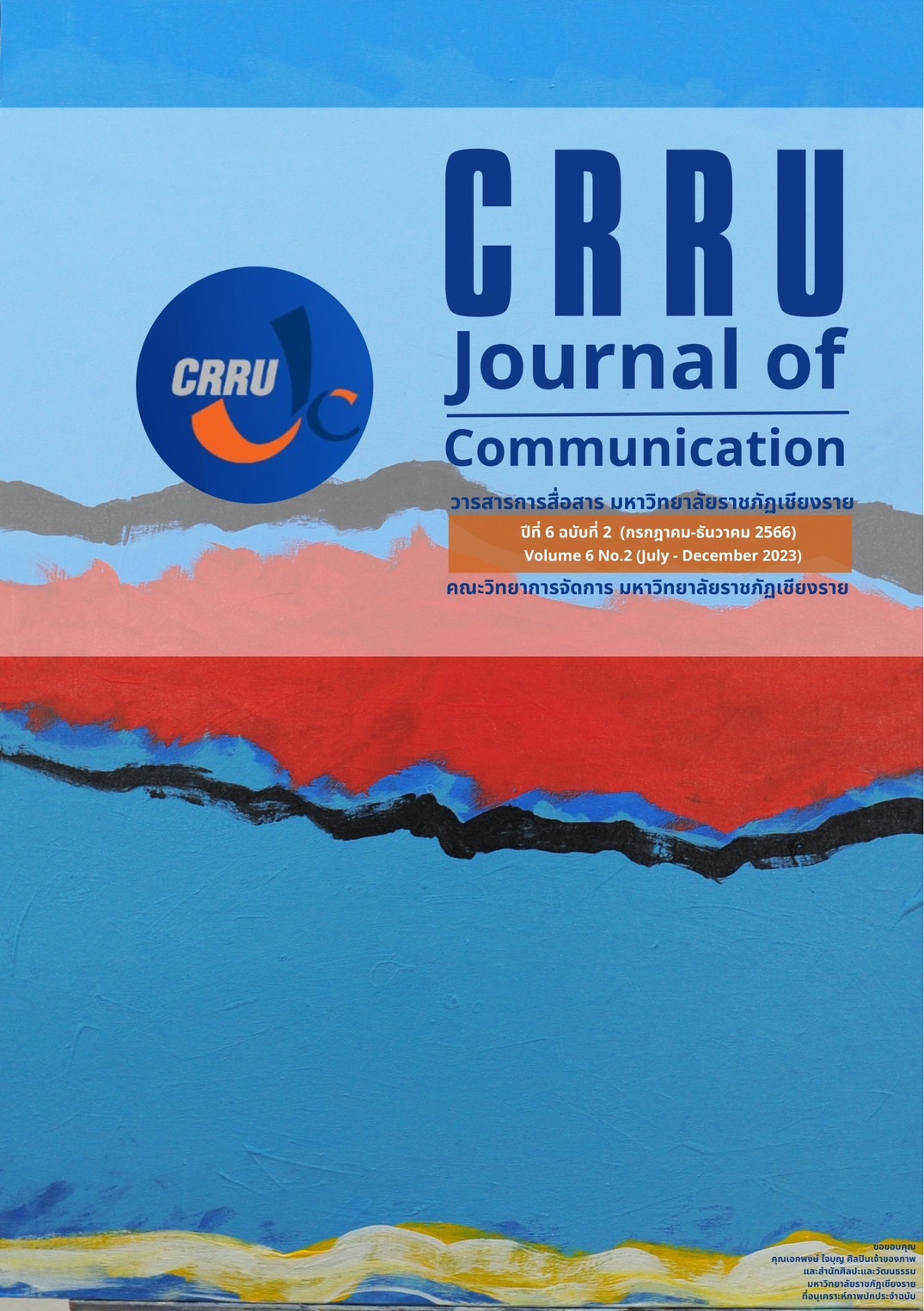Developing Creative Storytelling to Enhance the Value of Mon Khlong Sam Wa Community’s Rice Crackers
Main Article Content
Abstract
This research aims to develop storytelling to communicate the identity and increase the value of Mon Khlong Sam Wa crispy rice, or "Takhapeim," a traditional auspicious snack that plays a vital role in Mon culture. The research employed a purposive sampling method to select community product entrepreneurs through referrals from Mon Khlong Sam Wa community elders. The research employed the following methods: (1) Purposive Sampling: Community product entrepreneurs were selected through referrals from Mon Khlong Sam Wa community elders. (2) In-depth Interviews were conducted with three Mon Khlong Sam Wa crispy rice entrepreneurs and eight stakeholders to gain insights into the product. And (3) Participant Observation: The researchers participated in a cultural activity demonstrating the process of making Mon-style popped rice. Data analyzed using storytelling elements to inform community product communication strategies.
The research found that Mon-style popped rice, known as Takhapim, is a popular snack among the Mon people. It is associated with prosperity and abundance and is often used in auspicious ceremonies. The Khlong Sam Wa version of Mon-style popped rice is distinguished by the use of high-quality ingredients. However, some customers perceive the product as expensive despite its high quality. This perception can be attributed to a need for distinctive selling points and the absence of a narrative that effectively communicates the unique identity of Mon-style popped rice in Khlong Sam Wa.
The researchers employed a creative storytelling approach to develop and enhance narratives that effectively convey the identity of Mon-style popped rice products. This approach utilized the "2W1H" formula to create differentiation and establish a distinctive positioning for the product. These stories are designed to be creative and engaging, focusing on the local history of the Mon community of Khlong Sam Wa and the product's unique characteristics, with clear and concise language to ensure that everyone understands the message.
Article Details
References
กรวรรณ สังขกร, อาชว์บารมี มณีตระกูลทอง, ศันสนีย์ กระจ่างโฉม และชยานุช ชัยประเสริฐ. (2560). แนวทางการพัฒนาผลิตภัณฑ์การท่องเที่ยวเชิงวัฒนธรรมเพื่อสร้างมูลค่าเพิ่ม กรณีศึกษา: เส้นทางท่องเที่ยวอารยธรรมล้านนา. เชียงใหม่: สถาบันวิจัยสังคม มหาวิทยาลัยเชียงใหม่.
กฤษฎา สุริยวงค์, สุวันชัย หวนนากลาง และ ฐิตินัน บุญภาพ คอมมอน. (2564). การสื่อสารเพื่อการพัฒนาการท่องเที่ยวเชิงสร้างสรรค์โดยชุมชนมีส่วนร่วมของจังหวัดเพชรบุรี. วารสารมนุษยสังคมปริทัศน์ (มสป.), 23(1), 43-57.
คลังความรู้. (2565). storytelling ประโยชน์ทางการตลาดที่มากกว่าการเล่าเรื่อง. สืบค้นจาก https://rb.gy/vvrxhb
จุฑารัตน์ พรหมทัต. (2564). สร้างแบรนด์ชุมชน เสริมแกร่งให้เศรษฐกิจฐานราก. กรุงเทพฯ: สำนักงานนโยบายและยุทธศาสตร์การค้า.
ชวัลลักษณ์ คุณาธิกรกิจ. (2557). การสื่อสารเพื่อสร้างการมีส่วนร่วมและการเตรียมความพร้อมในการพัฒนาตราสินค้าด้านการท่องเที่ยวไทยเชิงสร้างสรรค์เพื่อเข้าสู่การเป็นศูนย์กลางการท่องเที่ยวกลุ่มประชาคมเศรษฐกิจอาเซียนของผู้มีส่วนเกี่ยวข้องในฐานะผู้กำหนดนโยบาย. วารสารสังคมศาสตร์ มหาวิทยาลัยศรีนครินทรวิโรฒ, 17(17), 64-82.
ทิฆัมพร เพทราเวช. (2566). แนวทางการพัฒนาทักษะทางการตลาดและการจัดการช่องทางการจัดจำหน่ายสินค้าชุมชนในจังหวัดศรีสะเกษ เพื่อยกระดับความสามารถทางการแข่งขันในยุคปัจจุบัน. วารสารวิชาการมนุษยสังคมสาร, 21(1), 23-45.
ทิพย์สุดา ปานเกษม. (2559). การสื่อสารแบบมีส่วนร่วมเพื่อส่งเสริมการท่องเที่ยวเชิงสร้างสรรค์ในจังหวัดน่าน. (วิทยานิพนธ์ศิลปศาสตรมหาบัณฑิต). สถาบันบัณฑิตพัฒนบริหารศาสตร์. กรุงเทพฯ.
นิษฐา หรุ่นเกษม, สิริมณฑ์ พึ่งสังวาลย์ และ นิศรารัตน์ วิไลลักษณ์. (2567). นวัตกรรมการพัฒนาและยกระดับการสื่อสารผลิตภัณฑ์ชุมชนเชิงสร้างสรรค์ เพื่อเพิ่มมูลค่าการท่องเที่ยวเชิงวัฒนธรรมบนฐานอัตลักษณ์ท้องถิ่นริมน้ำ เขตคลองสามวา สำหรับผู้ประกอบการสูงวัย กรุงเทพมหานคร. กรุงเทพฯ: สำนักงานกองทุนสนับสนุนการวิจัย.
เมธาวี จำเนียร. (2564). อัตลักษณ์ผลิตภัณฑ์ชุมชนสู่การสร้างและสื่อสารแบรนด์กรณีศึกษา การแสดงรำโทนนกพิทิด. วารสารราชพฤกษ์, 19(2), 1-12.
ศศิพร รัตนสุวรรณ์ และคณะ. (2563). การพัฒนาศักยภาพการบริหารจัดการการท่องเที่ยวโดยชุมชนเชิงสร้างสรรค์บนฐานอัตลักษณ์ชุมชน “โบสถ์ ศาลเจ้า วัด มัสยิด วิถีชีวิตริมสายน้ำ” ในเขตกรุงเทพมหานคร. กรุงเทพฯ: สำนักงานการวิจัยแห่งชาติ (วช.).
สรรเพชร เพียรจัด และ จารินี ม้าแก้ว. (2564). การพัฒนาท่องเที่ยวเชิงสร้างสรรค์โดยชุมชนบนดินแดนภูเขาไฟบุรีรัมย์. วารสารวิจัยและพัฒนา มหาวิทยาลัยราชภัฏบุรีรัมย์, 16(1), 41-49.
Kasemsarn, K. (2017). A framework for inclusive digital storytelling for cultural tourism in Thailand. Retrieved from https://search.ebscohost.com/login.aspx?direct=true&db= ddu&AN=4F7977BE3FC42166&site=ehost-live
Miller, E. (2011). Theories of story and storytelling. Storytelling and Video Conferencing, 67. Retrieved from https://storytellingandvideoconferencing.com/67.pdf
Lin, J., Kang, Y., Hong, L., and Huang, Y. (2022). Can cultural tourism experience enhance cultural confidence? The evidence from Qingyuan Mountain. Front Psychology, 13, 1-11.
Stainton, H. (2023). What is cultural tourism and why is it growing?. Retrieved from https://tourismteacher.com/cultural-tourism/
Theuma, N. (2002). Identifying the cultural tourism product in Malta: marketing and management issues. Retrieved from https://search.ebscohost.com/login.aspx?direct=true&db= ddu&AN=43031FF35964AA65&site=ehost-live

